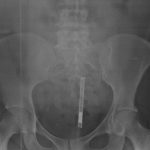This is the first in a series of articles on interesting abstracts presented at the 23rd Annual Scientific Assembly of the Eastern Association for the Surgery of Trauma in Phoenix, Arizona.
C-spine clearance in obtunded trauma patients has been problematic for some time. The options have been:
- CT plus MRI. This is probably only valid for the first 72 hours after injury, and entails some risk in placing a critically ill patient inside the MRI for 30 minutes or more.
- CT plus flexion/extension images under fluoroscopy. These are generally only performed by a few brave souls.
- Leave the collar on until a clinical exam can be performed. This frequently leads to significant skin breakdown problems.
The authors have been reviewing their experience with using CT scan alone. In this paper, they used this technique in patients who met the following criteria:
- Obtunded
- Blunt trauma
- CT normal, as read by a neuroradiologist
- Moving all extremities
They studied 197 patients, and found no injuries in all surviving patients (11% were lost to followup). One deceased patient had a stable ligamentous injury without spine fracture seen at autopsy. Using this technique resulted in a decrease in the average number of days to spine clearance from 7.5 to 3.3 days, a decrease in skin breakdown from 5% to 0.5%. A decreased length of stay from 23.4 to 13.8 days was also seen, but this could not be attributed to the collar.
Very intriguing! However, the fear of SCIWORA is high in all who clear c-spines. The rarity of this catastrophic problem means that no existing study has the statistical power to show that this type of clearance is safe.
Bottom line: We all need to decide “How many missed injuries is okay?” We will never be able to absolutely clear 100.000% of c-spines by xray alone, or even by adding a clinical exam. This study provides support for one technique, but eventually a catastrophic injury will occur. Who will decide what constitutes an acceptable complication and with what frequency they will occur?
Reference: A Normal CT Alone May Clear the Cervical Spine in Obtunded Blunt Trauma Patients with Gross Extremity Movement – A Prospective Evaluation of a Revised Protocol. Leukhardt, Como, Anderson, Wilczewski, Samia, Claridge. MetroHealth Medical Center, Cleveland, OH.

